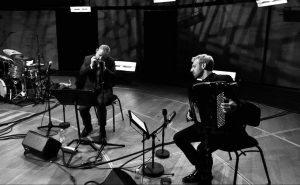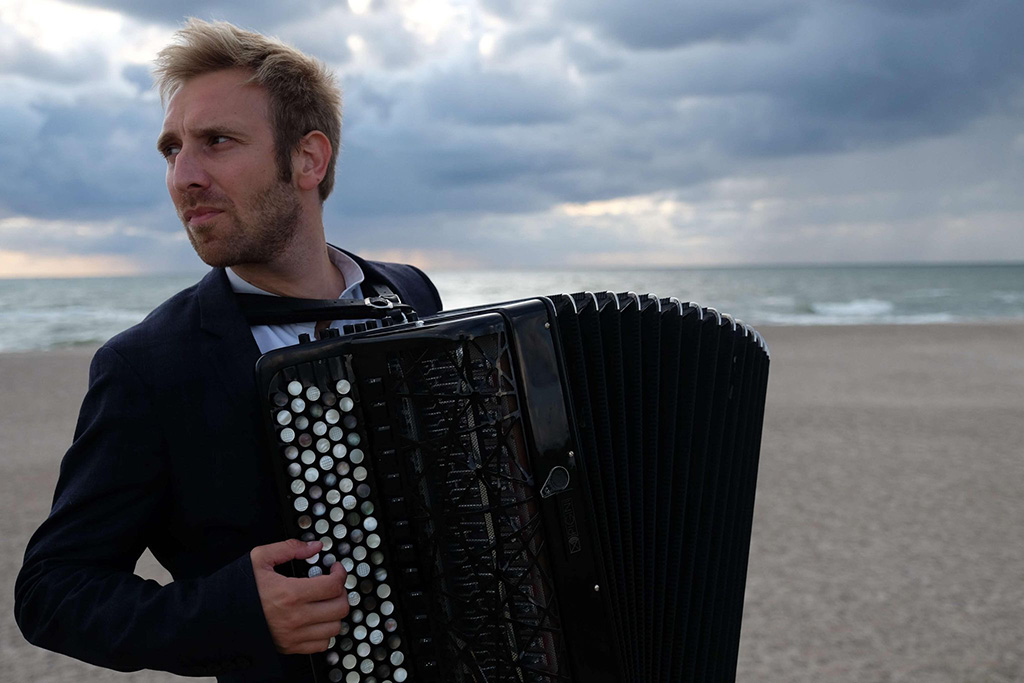La curiosità prima di tutto – Intervista a Bjarke Mogensen
 La Danimarca si sa, è sempre stata una terra fertile per la fisarmonica: è proprio qui che il valido fisarmonicista Bjarke Mogensen coltiva i propri progetti artistici, puntando, come ci spiega in questa intervista, a soddisfare la sua e la nostra curiosità.
La Danimarca si sa, è sempre stata una terra fertile per la fisarmonica: è proprio qui che il valido fisarmonicista Bjarke Mogensen coltiva i propri progetti artistici, puntando, come ci spiega in questa intervista, a soddisfare la sua e la nostra curiosità.
Lo scorso aprile hai registrato Løftet af vinden (Sollevato dal vento), un brano per fisarmonica sola composto dalla giovane e talentuosa Lil Lacy. È molto delicato, anche se vengono utilizzati alcuni effetti che normalmente pongono in evidenza l’energia intrinseca della fisarmonica: è il risultato dell’interpretazione di Bjarke Mogensen o è lo stile di Lil Lacy?
L’approccio alla composizione di musica strumentale di Lil Lacy è molto affascinante. Ha origini americane e danesi e il suo stile corrisponde a un’inconsueta combinazione tra lo studio accademico di canto jazz e studi avanzati di composizione avanguardista. Il suo background e gli studi sia accademici che di ricerca personale e tecnica sulla respirazione collimano con alcuni aspetti della fisarmonica. Lavorare con Lil Lacy è quasi come andare da un fisioterapista che analizza quali movimenti sono positivi e naturali per lo strumento e per l’esecutore. In questo senso, sento che il brano è stato scritto in maniera specifica per me, ma spero presto di sentire altri fisarmonicisti interpretarlo in futuro.
Con il Duo MYTHOS siete andati contro la tendenza di suonare musica originale per fisarmonica o musica antica e barocca, principalmente per tastiera o organo: infatti, nel vostro ultimo lavoro Helios and The Planets (Gateway Music, 2020), avete trascritto due brani sinfonici composti nel primo ventennio del ventesimo secolo. Ascoltando l’album, è evidente che avete fatto un enorme lavoro: quanto enorme? Quali sono state le principali difficoltà nel ridurre una partitura così ricca di timbriche diverse?
Il lavoro è stato enorme, è vero, ma molto gratificante! È stata un’occasione per studiare questi capolavori storici in maniera approfondita e per sperimentare come utilizzare il tempo e la scansione ritmica per costruire simili imponenti strutture di orchestra sinfonica. Naturalmente, non possiamo competere nell’ambito del volume, ma abbiamo la possibilità di essere estremamente precisi nell’espressività, cosa difficile da realizzare con un’orchestra sinfonica al completo. Sia in Nielsen che in Holst ci siamo poi resi conto di quanto la musica e le canzoni popolari scorrano all’interno di entrambe le opere, e questo è qualcosa che il suono della fisarmonica può far risaltare facilmente.
 Recensendo il vostro album, il critico Joshua Creek ha scritto: “È necessario far notare i veri maghi e mistici dietro al Duo MYTHOS: Viktor Melnyk, il maestro accordatore di fisarmoniche ucraino, e il maestro Vasiliev (colui che ha costruito le voci delle fisarmoniche dei due musicisti [N.d.R.]), perché hanno provveduto a fornire uno spettro sonoro di gamma orchestrale”: avete adottato nuovi approcci in questo aspetto, rispetto al precedente lavoro (Russian music for two accordions, Orchid Classics, 2013)?
Recensendo il vostro album, il critico Joshua Creek ha scritto: “È necessario far notare i veri maghi e mistici dietro al Duo MYTHOS: Viktor Melnyk, il maestro accordatore di fisarmoniche ucraino, e il maestro Vasiliev (colui che ha costruito le voci delle fisarmoniche dei due musicisti [N.d.R.]), perché hanno provveduto a fornire uno spettro sonoro di gamma orchestrale”: avete adottato nuovi approcci in questo aspetto, rispetto al precedente lavoro (Russian music for two accordions, Orchid Classics, 2013)?
Il lavoro svolto da Viktor Melnyk nell’ottenere la giusta corrispondenza della gamma dinamica tra gli strumenti è una parte molto importante della sonorità del Duo MYTHOS. Siamo quindi molto grati nell’aver lasciato nelle mani di Viktor i nostri strumenti prima delle registrazioni e dei concerti. È un dono poter collaborare con lui. Questo, combinato con le possibilità dinamiche delle voci prodotte da artigiani russi, ci dà una magnifica tavolozza di colori per interpretare la musica sinfonica di qualsiasi compositore.
Suoni anche in duo con un mezzosoprano, Andrea Pellegrini: che tipo di repertorio affrontate? Ci sono delle peculiarità nel suonare con una cantante?
Trovo in realtà abbastanza semplice seguire una cantante dal punto di vista fisico, dal momento che il suo respiro è strettamente connesso alla musica che esegue. La differenza principale è che devi fare attenzione che il pubblico riesca ad ascoltare e comprendere le parole e non solo le note. C’è spesso una sottile agogica coinvolta in questo processo se le parole sono complicate e anche se la musica sembra semplice. Riguardo al repertorio, dipende sempre dalla cantante coinvolta, ed è un piacere lavorare con una artista come Andrea, alla quale piace sfidare lo stereotipo di ciò che un mezzosoprano può o non può fare. Abbiamo eseguito sia musica del primo Rinascimento che nuovi cicli di canzoni scritte per noi, ma anche tango nuevo e standard jazz. Il nostro più recente progetto è incentrato sul ciclo di lieder di Schubert Winterreise. Qui sfidiamo le convenzioni utilizzando una traduzione in danese, una voce femminile al posto del tenore e una fisarmonica al posto del pianoforte.
Cosa viene apprezzato maggiormente della fisarmonica dai musicisti con cui ti esibisci?
Può sembrare ovvio per i fisarmonicisti, ma, per la mia esperienza, la principale caratteristica del nostro strumento che ancora affascina coloro con i quali collaboro è che abbiamo la possibilità di plasmare le note mentre le suoniamo. Il fatto è che la fisarmonica è forse ancora uno strumento da camera sottostimato, ma la mia impressione è che stia guadagnando reputazione in molti paesi.
 Sei d’accordo con loro? È quello che apprezzi anche tu del tuo strumento?
Sei d’accordo con loro? È quello che apprezzi anche tu del tuo strumento?
Certo, sono d’accordo! Altrimenti non farei questo lavoro per vivere.
Kottos è un altro progetto interessante, e il vostro ultimo album Songs and Dances (Orchid Classics, 2019) è a mio parere un esempio magistrale di trascrizione, strumentazione e gestione sapiente delle melodie. Come si è sviluppato questo lavoro?
Ho iniziato il progetto Kottos quando mi sono reso conto di conoscere quattro musicisti che sarebbero potuti essere coinvolti in un gruppo speciale. Includendo il bouzouki, un particolare tipo di mandolino greco. Fui ispirato dalla tipica formazione russa domra/balalaika/bayan che può avere una sonorità orchestrale simile, sebbene risulti ancora molto esotica in occidente.
Credo che la tua abilità nel mescolare il suono del tuo strumento con altri sia generato da una grande curiosità nell’ascoltare e trovare inusualità musicali intorno a te: ti consideri un ascoltatore curioso? Cosa ascoltavi quando eri uno studente della Royal Danish Academy a Copenhagen?
Ritenendomi un autentico nerd, la curiosità è una parte rilevante della mia vita creativa come musicista. Provo sempre e in maniere diverse combinazioni tra strumenti insoliti, così come repertori sia famosi che sconosciuti, che possono adattarsi al suono della fisarmonica ed essere in seguito combinati con altri strumenti. A volte, ciò può avvenire in maniera più casuale, perché le mie scelte e la loro direzione si basano sui musicisti e non sugli strumenti. Questo, quindi, non è sempre intenzionale, ma spesso finisco per esibirmi insieme a determinati strumenti per la mia urgenza di suonare un certo brano in un certo modo, o per cercare un particolare colore sonoro per un dato brano.
 Abbiamo visto esibirti anche in duo con un suonatore di armonica a bocca: quali altri suoni vorresti sperimentare in futuro?
Abbiamo visto esibirti anche in duo con un suonatore di armonica a bocca: quali altri suoni vorresti sperimentare in futuro?
Ultimamente ho cominciato a esplorare un duo molto inusuale insieme a un musicista jazz, armonicista e compositore, Matthias Heise. Lui è per me il tipo di musicista che avrebbe potuto prendere in mano qualsiasi strumento e diventare un pioniere in molti settori musicali, quindi anche questo è stato un caso di ispirazione determinata dalla stessa musicalità di Heise. Successivamente, ho scoperto che, in realtà, già Mogens Ellegaard ha avuto un duo simile all’inizio della sua carriera, quando, negli anni Sessanta, registrava con un armonicista cinese, Cham-Ber-Huang. Registrazioni molto affascinanti, realizzate negli Stati Uniti, nelle quali suonavano di tutto: da Bach e Couperin a Bartok e De Falla, ma anche musica originale per fisarmonica e armonica composta dallo stesso Mr. Huang. Sono sempre stato attratto dagli strumenti antichi come le viole, i liuti e gli strumenti a tastiera e dalla loro combinazione con la fisarmonica moderna, quindi i miei prossimi progetti probabilmente includeranno qualcosa del genere.
Il prossimo anno ricorre il centenario della nascita di Astor Piazzolla. Secondo te, abbiamo raggiunto i limiti nell’interpretazione della sua musica, o possiamo ancora far emergere la sua vena innovativa?
Per il fatto che non la eseguo con il bandoneon, e che non punto necessariamente a un’interpretazione autentica della musica di Piazzolla, ho deciso di affrontarla sempre con cuore e mente aperti. La musica di Piazzolla è per me come un parco giochi creativo nel quale posso improvvisare un po’ e pensare fuori dagli schemi. Ciò che spesso rende grande la sua musica, e che rende eccitante l’affrontarla, è il fatto che egli lascia uno spazio all’esecutore per poterla riempire con la sua creatività o con l’improvvisazione. La sua curiosità verso generi diversi è poi ammirabile. Trovo particolarmente stimolante in Piazzolla la grande differenza e variazione interpretativa del suo lavoro. Questo avviene sviluppando sempre nuove direzioni e combinazioni di strumenti mantenendo così le melodie e i ritmi freschi e originali nelle mie orecchie.
Salutiamoci con due consigli per i giovani musicisti. Mr. Mogensen, a lei la parola!
Spero che non risultino due grandi cliché ma proviamoci: va bene imitare, ma cerca di evitare di copiare. Ascoltare, adattare e sviluppare, o anche rinnovare, è molto più entusiasmante e soddisfacente nel lungo periodo. Punta a qualcosa di autentico e ricorda di gratificare te stesso per aver assunto rischi e fallimenti, nella stessa misura in cui ti gratifica l’apprezzamento del pubblico. E ricordati di ascoltare e suonare un po’ di Scarlatti e di Stravinsky ogni giorno.
(Foto in evidenza by Birgitte Tengbjerc – foto 1 Martin Mydstkov – foto 2 Nicolaj Lund – foto 3 Martin Mydstov – foto 4 Danish Radio Live Broadcast)
————————————————————————————
Curiosity, first of all – Interview to Bjarke Mogensen
 Denmark has always been a fertile land for accordion: here is where the talented accordionist Bjarke Mogensen cultivates his artistic projects, aiming, as he explains in this interview, to satisfy his and our curiosity.
Denmark has always been a fertile land for accordion: here is where the talented accordionist Bjarke Mogensen cultivates his artistic projects, aiming, as he explains in this interview, to satisfy his and our curiosity.
In April you recorded Løftet af vinden (“Windborne”), a piece for solo accordion composed by the young talented artist Lil Lacy. It sounds very delicate, even if there are some effects that are normally used to show the inherent energy of the accordion: is it the Bjarke Mogensen’ interpretation or the Lil Lacy’ style?
Lil Lacy’s approach to writing for instrumentalists is very fascinating. She is half American/Danish and a rare combination of academy trained jazz singer crossing over to a post degree of avant-garde score-writing. Her background and study of the human breath through academic theory and song-technical research fits the accordion very well. Working with Ms. Lacy is almost like going to a physiotherapist who analyses which movements are healthy for the instrument as well as the performer. I feel like the piece was written very specifically for me in that sense, but I look forward to hearing other accordionists interpretations of this piece in the future.
With MYTHOS Accordion Duo you go against the trend to play original contemporary music for accordion or baroque and ancient music, mostly for keyboard or organ: in fact, in your last work Helios and The Planets (Gateway Music, 2020), you transcribed two symphonic pieces composed in the first two decades of the twentieth century. Listening to the album, it’s evident that the work has been huge: how huge? Which were the main difficulties to reduce such a rich-of-timbres score?
The work was huge, yes but very rewarding! You get to study these historic master pieces in a very thorough way and experiment how to use timing and pulse to build up the similar massive textures of the symphonic orchestra. Naturally we cannot compete in the sense of dynamic volume but we have the possibility to be extremely precise in our expression which is hard to do with a complete symphonic ensemble. In both Nielsen and Holst we also realised how much folk music and folk songs go through both works, something that the sound of the accordion can easily provide.
 Reviewing your album, Mr. Joshua Creek says that “It’s essential to talk about the true magician and mystic behind the MYTHOS duo, Viktor Melnyk, the master bayan tuner from Ukraine, and Maestro Vasiliev”, because they provided to give you an “orchestral spectrum of sound”: have you adopted new approaches in this aspect, compared to the previous album (Russian music for two accordions, Orchid Classics, 2013)?
Reviewing your album, Mr. Joshua Creek says that “It’s essential to talk about the true magician and mystic behind the MYTHOS duo, Viktor Melnyk, the master bayan tuner from Ukraine, and Maestro Vasiliev”, because they provided to give you an “orchestral spectrum of sound”: have you adopted new approaches in this aspect, compared to the previous album (Russian music for two accordions, Orchid Classics, 2013)?
Viktor Melnyk’s work with getting the right match of dynamic range between the instruments is very much a big part of MYTHOS Duo’s sound. So we are very grateful to have Victor’s work on our instruments before recordings and concerts. It’s a gift to work with him. That combined with the dynamic possibilities of the reeds from Russian reed-makers gives us an amazing colour palette when we are interpreting the symphonic music of any composer.
You also play in duo with a soprano, Andrea Pellegrini: which type of repertoire do you propose? Are there any peculiarities in playing with a singer?
Actually I find it quite straight-forward to follow a singer muscially speaking, since their breathing is so connected to the music they perform. The main difference is that you also have to take care that the audience can hear and understand the words and not only the notes. There is often a lot of micro-timing involved in that process if the words are complicated even though the music seems simple. About the repertoire, it always depends on the particular singer, and it is a delight to work with a singer such as Andrea who likes to challenge the idea of what a mezzo-Soprano is supposed to perform and not. We have performed music from the early renaissance to brand new song cycles written for us, as well as tango nuevo and jazz standards. Our latest project is centered around Schubert’s song cycle Winterreise. Here we triple-cross the conventions with a Danish translation, a female singer instead of tenor and accordion instead of piano.
What is most appreciated about the accordion by the musicians you play with?
It may sound obvious to accordionists, but my experience is that the main feature of the instrument still fascinates my collaborators is that we have the possibility to shape the notes while we play them. The accordion is perhaps after all still an underestimated chamber music instrument but my impression is it is gaining a growing reputation in many countries.
 Do you agree with them? What do you like most about your instrument?
Do you agree with them? What do you like most about your instrument?
I do! Otherwise I would probably not be doing this for a living.
Another interesting project is Kottos, and your last album Songs and Dances (Orchid Classics, 2019) is, in my opinion, a masterful example of transcription, instrumentation and wise management of melodies. How did this work develop?
I started Kottos when I realised I had 4 great musicians that could be put into a unique group. Including the bouzouki, a unique greek type of mandolin, I was definitely inspired by the well known Russian domra/balalaika/bayan constellation which in sound can have a similar orchestral colour palette though it is still very exotic in the west.
I think that your ability in mixing the sound of your accordion with other instruments is determined by a big curiosity in listening and finding musical unusualness around you: do you consider yourself a curious listener? What did you listen to when you were a student in the Royal Danish Academy?
Being a real nerd, curiosity is a big part of my creative life as a musician. I am somehow always testing out unusual instrument combinations as well as well known or unknown repertoire that can fit in the sound world of the accordion often combined with other instruments. Sometimes it can be random since the musicians and not the instrument, often determine my choices and directions. So this is not always intentional but often I end up performing with instruments out of my urge to perform a certain piece of music in a certain way or searching for a certain sound colour for a given piece.
 We have also seen you perform in duo with a harmonica player: what other sounds would you like to experience in the future?
We have also seen you perform in duo with a harmonica player: what other sounds would you like to experience in the future?
Lately I started exploring a very unusual duo with the jazz musician, harmonica player and composer, Mathias Heise. To me, he is the kind of musician who could have taken up any instrument and become a pioneer in many fields of music so this again was mostly a case of inspiration towards Heise’s completely inspiring musicianship. Later on I discovered that the young Mogens Ellegaard actually already had a similar duo when recording in the 60’s with the Chinese harmonica player, Cham-Ber Huang. A very fascinating recording, made in the US, where they perform everything from Bach and Couperin to Bartok and De Falla as well as an original piece for accordion and harmonica composed by mr. Huang. I was always fascinated by early instruments such as the viols, lutes and keyboard instruments with the modern accordion, so my next project will probably include something in that direction.
Next year marks the centenary of Astor Piazzolla’s birth. In your opinion, have we reached the borders of interpretation of his music, or can we still bring out its innovative streak?
Due to the fact that I am not performing this music on the bandoneon, and not necessarily aiming for an authentic take on Piazzolla’s music I decided to always go with an open heart and mind towards this music. For me Piazzolla’s music is a kind of creative playground where I get to improvise a little and think ‘out of the box’. What often makes his music great and exciting to work with for me, is that he leaves a little room for the performers to fill in or improvise a bit. His curiosity towards many different genres is also very admirable. What I find especially fascinating with Piazzolla is the huge difference and variation in his own interpretation of his work. Always developing in new directions and instrument combinations keeping the tunes and rhythms fresh and original in my ears.
Let’s say goodbye with two music tips for young musicians. Mr. Mogensen, the floor is yours!
I hope this doesn’t come out as two big clichés but here we go: It is OK to imitate but try to avoid simply copying. To listen, adapt and develop or renew is much more fun and rewarding in the long run. Aim for something “real” and remember to acknowledge yourself for taking risks and failures just as much as you do with the audience’s appreciation. And remember to listen to and practice a little bit of Scarlatti and Stravinsky every day.

